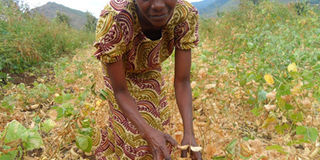Forget beans, njahi gives me better deal

Martha Gatura in her farm in Tigania, Meru County. LEOPOLD OBI | NATION MEDIA GROUP
What you need to know:
- I have been growing njahi over the years and the returns are high compared to maize and normal beans. Last season I harvested 1,350kg of dolichos, which is 14 90kg bags.
- The problem was that when I started, I had very little information on the crop. The person who encouraged me did not tell me much. To her, growing njahi was no different from farming normal beans.
- Armed with the knowledge, I planted the njahi in 2011 and harvested 13 bags from my 1.5 acre farm. This encouraged me as I earned Sh70,000 as each 90kg bag went for Sh5,500.
When a friend advised me to ditch maize for dolichos beans (njahi) in 2010, I was confident that that would be the best thing for me.
From the way she put it, I was to plant, weed and wait for a bumper harvest.
It made great sense to me then. Around that time, I desperately needed to raise money for my children’s school fees. They were in secondary schools. Three of them.
Again, my maize was not doing very well. I had grown it on my 1.5 acre farm, harvested about 10 bags, but the price was Sh1,500 a bag, which was very low.
I, therefore, did not hesitate to plant dolichos, after getting the seeds from a market in Tigania-East, where I farm.
But when the harvest came, it was even worse than maize. For the first time in many years, I harvested only three bags of njahi, about seven bags less than what I used to get from maize.
The problem was that when I started, I had very little information on the crop. The person who encouraged me did not tell me much. To her, growing njahi was no different from farming normal beans.
After this terrible loss, I had to do something to lift myself up because I didn’t want to go back to maize, whose prices were lower, and are still low. Help came in early 2011 inform of a workshop organised by Ministry of Agriculture and Farm Concern International.
Beside the management of this particular crop, which includes spraying pesticides at various stages, I also learned the importance of using quality certified seeds and fertiliser.
With others, I was linked to a farmer in the area who was successfully growing maize, pigeon and cow peas, beans and dolichos.
We called him Village Knowledge Worker. He was to advise us on pesticides and crop handling during planting to harvesting.
Around that time, we also formed a table banking group in the village through which we contributed Sh100 a week. It is from this group that I borrowed a soft loan of Sh10,000 to purchase certified seeds, pesticides and fertiliser for planting.
Armed with the knowledge, I planted the njahi in 2011 and harvested 13 bags from my 1.5 acre farm. This encouraged me as I earned Sh70,000 as each 90kg bag went for Sh5,500.
COMPARED TO MAIZE AND BEANS
I have been growing njahi over the years and the returns are high compared to maize and normal beans. Last season I harvested 1,350kg of dolichos, which is 14 90kg bags. This season I also got about the same bags. However, prices have dropped currently, at Sh90 per kilo, but I intend to store my produce until the price improves.
Njahi offers better returns because few farmers grow it. A kilo normally goes for between Sh100 and Sh150.
With njahi, you are assured of good harvest because it mainly does well in places with minimal rainfall.
I normally grow the beans 3 by 15 inches apart. They take five months to mature. It is advisable not to uproot njahi, which is also known as black beans, after first harvesting since they re-sprout and produce new pods and one harvests in the eighth month.
Njahi should be sprayed at least three times in its life span against thrips.
The first spraying comes two weeks after planting, then the second in the sixth week and finally when they are blossoming. Prof James Muthomi, a crop protection specialist at the University of Nairobi’s Department of Plant Science says njahi is a good alternative to maize and grows well in areas with little rainfall across the country.
“Most of these indigenous crops do not only survive in dry areas but give good yields unlike maize.”
Njahi is high in protein, folate, iron, vitamin B6, calcium, magnesium and phosphorus.
– As told to Leopold Obi




